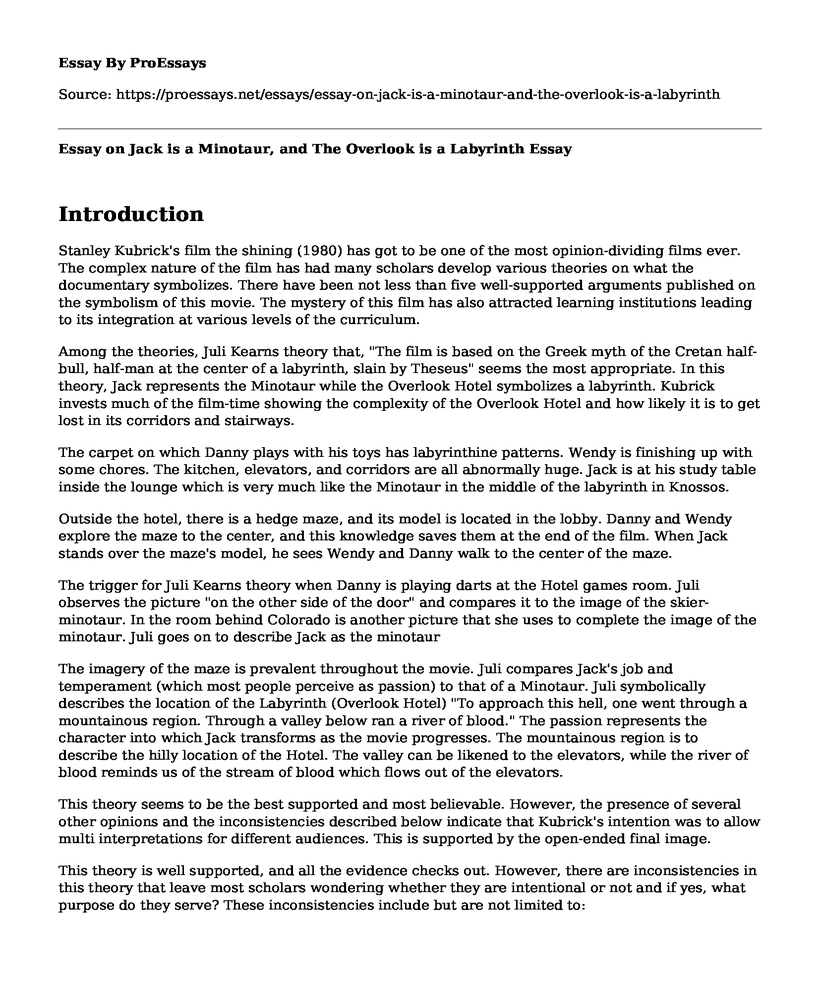Introduction
Stanley Kubrick's film the shining (1980) has got to be one of the most opinion-dividing films ever. The complex nature of the film has had many scholars develop various theories on what the documentary symbolizes. There have been not less than five well-supported arguments published on the symbolism of this movie. The mystery of this film has also attracted learning institutions leading to its integration at various levels of the curriculum.
Among the theories, Juli Kearns theory that, "The film is based on the Greek myth of the Cretan half-bull, half-man at the center of a labyrinth, slain by Theseus" seems the most appropriate. In this theory, Jack represents the Minotaur while the Overlook Hotel symbolizes a labyrinth. Kubrick invests much of the film-time showing the complexity of the Overlook Hotel and how likely it is to get lost in its corridors and stairways.
The carpet on which Danny plays with his toys has labyrinthine patterns. Wendy is finishing up with some chores. The kitchen, elevators, and corridors are all abnormally huge. Jack is at his study table inside the lounge which is very much like the Minotaur in the middle of the labyrinth in Knossos.
Outside the hotel, there is a hedge maze, and its model is located in the lobby. Danny and Wendy explore the maze to the center, and this knowledge saves them at the end of the film. When Jack stands over the maze's model, he sees Wendy and Danny walk to the center of the maze.
The trigger for Juli Kearns theory when Danny is playing darts at the Hotel games room. Juli observes the picture "on the other side of the door" and compares it to the image of the skier-minotaur. In the room behind Colorado is another picture that she uses to complete the image of the minotaur. Juli goes on to describe Jack as the minotaur
The imagery of the maze is prevalent throughout the movie. Juli compares Jack's job and temperament (which most people perceive as passion) to that of a Minotaur. Juli symbolically describes the location of the Labyrinth (Overlook Hotel) "To approach this hell, one went through a mountainous region. Through a valley below ran a river of blood." The passion represents the character into which Jack transforms as the movie progresses. The mountainous region is to describe the hilly location of the Hotel. The valley can be likened to the elevators, while the river of blood reminds us of the stream of blood which flows out of the elevators.
This theory seems to be the best supported and most believable. However, the presence of several other opinions and the inconsistencies described below indicate that Kubrick's intention was to allow multi interpretations for different audiences. This is supported by the open-ended final image.
This theory is well supported, and all the evidence checks out. However, there are inconsistencies in this theory that leave most scholars wondering whether they are intentional or not and if yes, what purpose do they serve? These inconsistencies include but are not limited to:
- The hedge maze is not present during the first look.
- The window facing the trees that we see during Jack's interview is impossible given the front desk layout of the hotel.
- Inconsistencies in the interior geography of the hotel and other instant inconsistencies in the architecture of the hotel.
Conclusion
This analysis is an expository one rather than persuasive. This is because it only explains the theory without taking much of a stand on it. All though it has several shared qualities of a strong analysis, it is still expository.
Reference
Ascher, Rodney. Room 237. 2012.
Artur, Piskorz. "Jack In Wonderland Temporal, Spatial and Mental Labyrinths in Stanley Kubrick''s the Shining." Mezdunarodnyi zurnal issledovanii kultury 2 (11) (2013).
Cite this page
Essay on Jack is a Minotaur, and The Overlook is a Labyrinth. (2022, May 22). Retrieved from https://proessays.net/essays/essay-on-jack-is-a-minotaur-and-the-overlook-is-a-labyrinth
If you are the original author of this essay and no longer wish to have it published on the ProEssays website, please click below to request its removal:
- Irony, Foreshadowing, and Symbolism in The Lottery
- Plan of Action Towards the Company Social Media Failure
- Research Paper on Beauty Societal Standards
- Music in Promotional Campaigns Essay
- Writing for Readers Paper Example
- Social Media and Social Development Paper Example
- Essay Example on Exploring the Boundless Horizons of Creative Writing







